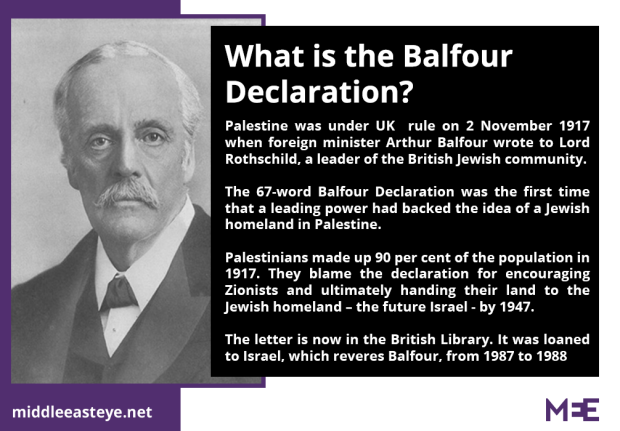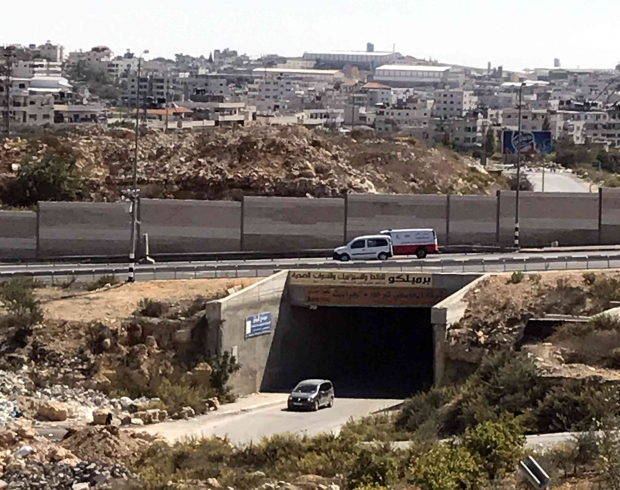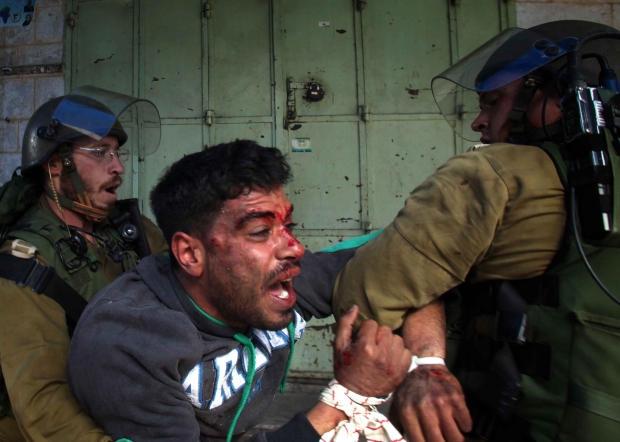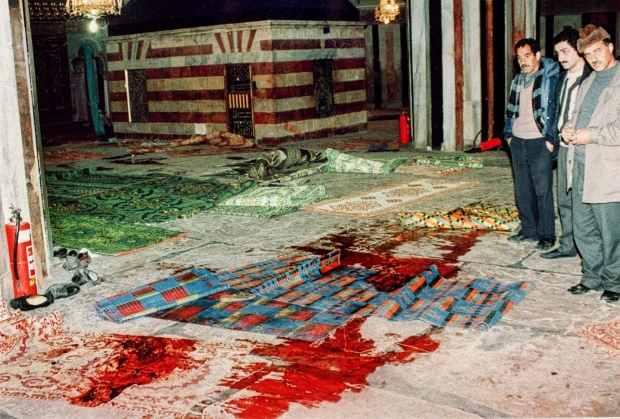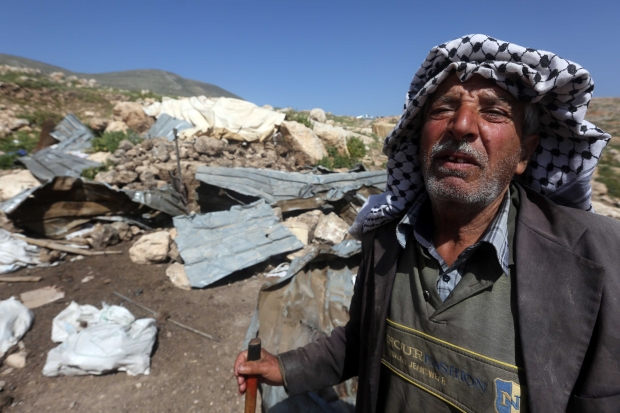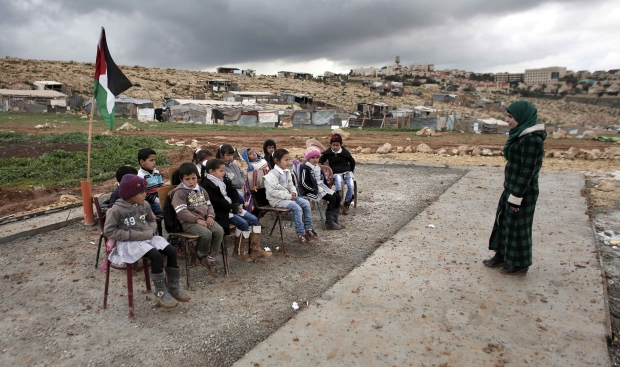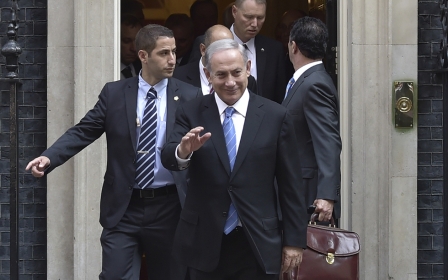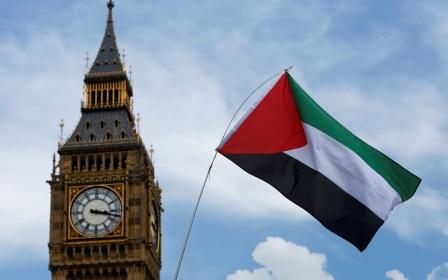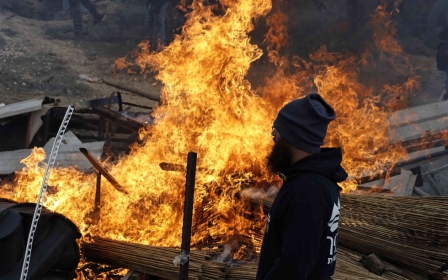100 years after Balfour: The reality which still shames Israel
OCCUPIED WEST BANK - Next week, exactly 100 years will have passed since British foreign secretary Arthur Balfour wrote his famous letter to Walter Rothschild, promising that Britain would help to create a “national home for the Jewish people” in Palestine.
Current prime minister Theresa May says that the Balfour Declaration was “one of the most important letters in history”. It led within barely three decades to the creation of the state of Israel. No wonder then that Benjamin Netanyahu flies to London next week to celebrate its anniversary.
It’s understandable Palestinian leaders weren’t invited. But they weren’t even consulted.This is wrong. The Balfour Declaration not only promised to deliver a homeland for the Jews. It also promised that “nothing shall be done which may prejudice the civil and religious rights of existing non-Jewish communities in Palestine”.
Has this promise been kept?
I flew to Israel and the West Bank to find out. The treatment of the Palestinians I witnessed is not just physically degrading for them. It is also morally degrading for the Israelis as well.
Hebron: Closed city for Palestinians
I drove to the West Bank city of Hebron, about an hour’s drive south of Jerusalem. When I typed “Hebron” into Waze (the local equivalent of Google Maps) a warning flashed up: “This destination is a high-risk area or is prohibited to Israelis by law.”
These soldiers - I’d guess at least one per settler - stand idly by as the settlers harass, persecute and assault the local population.
Palestinians said that only that morning, a masked settler had attacked two children aged 10 and 11 in the streets. I was told the soldiers made no attempt to intervene.
Such incidents, locals said, are common. In October 2015, student Dania Ersheid from Hebron was shot dead at a checkpoint. She was 17.
The Israeli army has created a ghost town in parts of Hebron’s Old City. In July, Unesco's heritage committee gave heritage status to these areas, much to the anger of Israel.
The ancient markets are mainly closed because of “security reasons”. More than 1,000 houses have been shut up and more than 1,300 shops have been closed.
I walked through this desolate area. Slogans such as “Hevron Yehudit” - “Hebron is Jewish” - have been scrawled on the walls. The Star of David was sprayed on the doors of many shops. The names of the streets have been changed from Palestinian to Hebrew.
I reached the Ibrahimi Mosque, known to Jews as the Tomb of the Patriarchs, where it is thought that Abraham, Isaac, Sarah, Jacob and Leah are buried.
If the magnificent teachings of these three great religions is to have any meaning, then all of us should come together at this site.
But there was an invisible line in the street outside which Palestinians may not cross. A Palestinian woman ventured too far along the road. A soldier asked her: “Are you Muslim?”
Unequal in death as in life
Inside, the site is divided, as so often is the case in Israel and occupied Palestine. One third is set aside for Muslims and two thirds are set aside for Jews.
The partition was built after 1994, when an Israeli settler called Baruch Goldstein, who emigrated from the United States, entered with a machine gun and shot dead 29 Muslim worshippers in cold blood. More were killed outside the hospital by the Israeli army amid protests.
Not far away is a little museum. I went in. It was empty and unattended. I called out.
A lady came out of a back room and showed me around. The first room was dedicated to the ancient Jewish presence in Hebron. The second concentrated on the massacre of Jews by Arabs in 1929, part of wider tension over access to the Wailing Wall in Jerusalem. It contained horrifying and vivid contemporary photographs and testimony of the atrocity, during which 69 Jews were killed.
This museum helped me to understand the absolute moral and religious certainty felt by the settlers that Hebron belongs to them. For them it is Arabs, not Jews, who are the usurpers.
As I left, I told my guide how moved I had been by the testimony of the 1929 atrocity. Then I asked her why her museum didn’t also mark the 1994 murder of Arabs by Goldstein.
Afterwards I drove up to the nearby settlement of Qiryat Arba, where Goldstein is buried. A guard nodded me through the entrance gate.
I found the grave behind a row of shops in a public park. Part of the Hebrew inscription read: “To the holy Baruch Goldstein, who gave his life for the Jewish people, the Torah, and the nation of Israel.” Beside the grave, a glass container contained two candles and some spent matches. Mourners had also individually laid many small stones, part of the Jewish mourning tradition.
I walked back to the shops and tried to talk to settlers. Most worked in the military or the police. They courteously refused to answer my questions.
I found a woman who said she had known Goldstein. “He was my doctor,” she told me. “He was a wonderful man. He was an amazing person who took care of the Arabs and the Jews as well.”
She said that she had come from the United States to Qiryat Arba as a child and that she was "against violence on both sides". As for Goldstein, she felt “there was something that pushed him over. There was a lot of violence on both sides at the time.”
But the woman insisted that there was nothing “symbolic” about Goldstein’s grave in Qiryat Arba. He was buried in the settlement, she said, because he could not be buried in nearby Hebron.
It needs little imagination to gauge how Israelis would react if a Palestinian who had shot dead 29 Jews in cold blood was given such a prominent resting place
It needs little imagination to gauge how Israelis would react if a Palestinian who had shot dead 29 Jews in cold blood was given such a prominent resting place in a West Bank town or village.
Bear in mind many Palestinians killed in attacks on Israelis are buried in secret cemeteries with unnamed (but numbered) graves. This means that the families of the dead cannot visit their loved ones.
Yet the religious terrorist and mass murderer Goldstein rests in peace in an honoured place in the Israeli settlement where he lived. This is but one example of the dual system in the Israeli-occupied West Bank.
Palestinians are subject to military law. Settlers are Israeli citizens, with all the protections of civil law.
Schools, homes, hope crushed
When I visited Israel 10 years ago with the lobby group Conservative Friends of Israel, my guides portrayed settlers as wild men and women who act independently of government in pursuit of a special religious vision.
I have to admit that before last week’s trip, I had wholly failed to grasp the extent to which the settlers have become part of the basic apparatus of the Israeli state.
There is colossal investment in infrastructure, roads, services and security for settlers. Meanwhile basic amenities and rudimentary security are denied to the Palestinians or - as the Balfour Declaration defines them - “the existing non-Jewish communities in Palestine.”
In the West Bank, these "non-Jewish communities” are vulnerable to arbitrary arrest and detention. Their houses get demolished without warning. They live Kafkaesque lives subject to the whim of inaccessible and largely hostile authorities, with none of the rights that come with citizenship.
Let’s meet Abdul Rahim Bisharat, a Bedouin chief who lives in al-Hadidiya, an isolated hillside encampment above the Jordan Valley.
Bisharat, 67, told me how the Israeli army had confiscated his livestock, shot his animals from jeeps and even helicopters, and repeatedly bulldozed his home.
At one stage they attacked his tents 32 times in just 16 days, he said.
As we spoke, Bisharat’s 10-year-old daughter Somood served us tea. Her name means “steadfastness” in Arab: she was born while Israeli bulldozers were demolishing the camp.
Somood’s education is a problem. Bisharat told me how he had built a school, only for it to be destroyed by the Israeli army. He tried to build a kindergarten. That was also destroyed.
In desperation the Bedouins decided to send their children to a school many kilometres away. This meant improving the track from the camp to the main road. But when they did this, the Israelis demolished their work.
Traditionally the Jordan River has been their main source of water, but the Bedouin are denied access because the river is a military zone.
The Bedouin take water from streams. But the Israelis dig deep artesian wells to access the underground water supply, so the streams have mainly dried up. Now they have to buy water from the same Israelis who took it from them.
The sheikh said that when the occupation of the West Bank started in 1967, his camp had included some 300 families amounting to 2,000 people. Now, just 16 families are left, scarcely amounting to 100 people.
“Some have sold their sheep and become workers in settlements,” he told me. “Others are unemployed. All the time we are chased and expelled from one area or another.”
How UK government still echoes Balfour
The Israelis want to relocate the Bedouin to what are are frequently called townships and end their ancient nomadic way of life.
There is a deep paradox lurking here. The Israelis impose their own arbitrary system of law on the West Bank. Yet the Israeli occupation is itself illegal under international law.
Theresa May’s exclusion of Palestinians from her celebration reflects the exclusion of Palestinians from the Balfour Declaration 100 years ago
Yes, the Jews have the national homeland promised by the British a century ago. I wholeheartedly concur with a common British view that no other people have suffered as much as the Jews at the hands of persecutors throughout their extraordinary history.
That is why I have always supported the existence of an Israeli state.
But May’s exclusion of Palestinians from her celebration next week reflects with uncanny accuracy the exclusion of Palestinians from the Balfour Declaration 100 years ago.
The British treated the Palestinians as non-people then, and still treat them as non-people today. I believe this scornful neglect may be even more damaging for Israelis than it is of the Palestinians themselves because it is such a betrayal of the idealistic and humane vision that brought Israel into being.
- Peter Oborne won best commentary/blogging in 2017 and was named freelancer of the year in 2016 at the Online Media Awards for articles he wrote for Middle East Eye. He also was British Press Awards Columnist of the Year 2013. He resigned as chief political columnist of the Daily Telegraph in 2015. His books include The Triumph of the Political Class, The Rise of Political Lying, and Why the West is Wrong about Nuclear Iran.
The views expressed in this article belong to the author and do not necessarily reflect the editorial policy of Middle East Eye.
Photo: Abdul Rahim Bisharat, a Bedouin chief who lives in al-Hadidiya, an encampment above the Jordan Valley (MEE), is interviewed by Peter Oborne
This article is available in French on Middle East Eye French edition.
New MEE newsletter: Jerusalem Dispatch
Sign up to get the latest insights and analysis on Israel-Palestine, alongside Turkey Unpacked and other MEE newsletters
Middle East Eye delivers independent and unrivalled coverage and analysis of the Middle East, North Africa and beyond. To learn more about republishing this content and the associated fees, please fill out this form. More about MEE can be found here.



